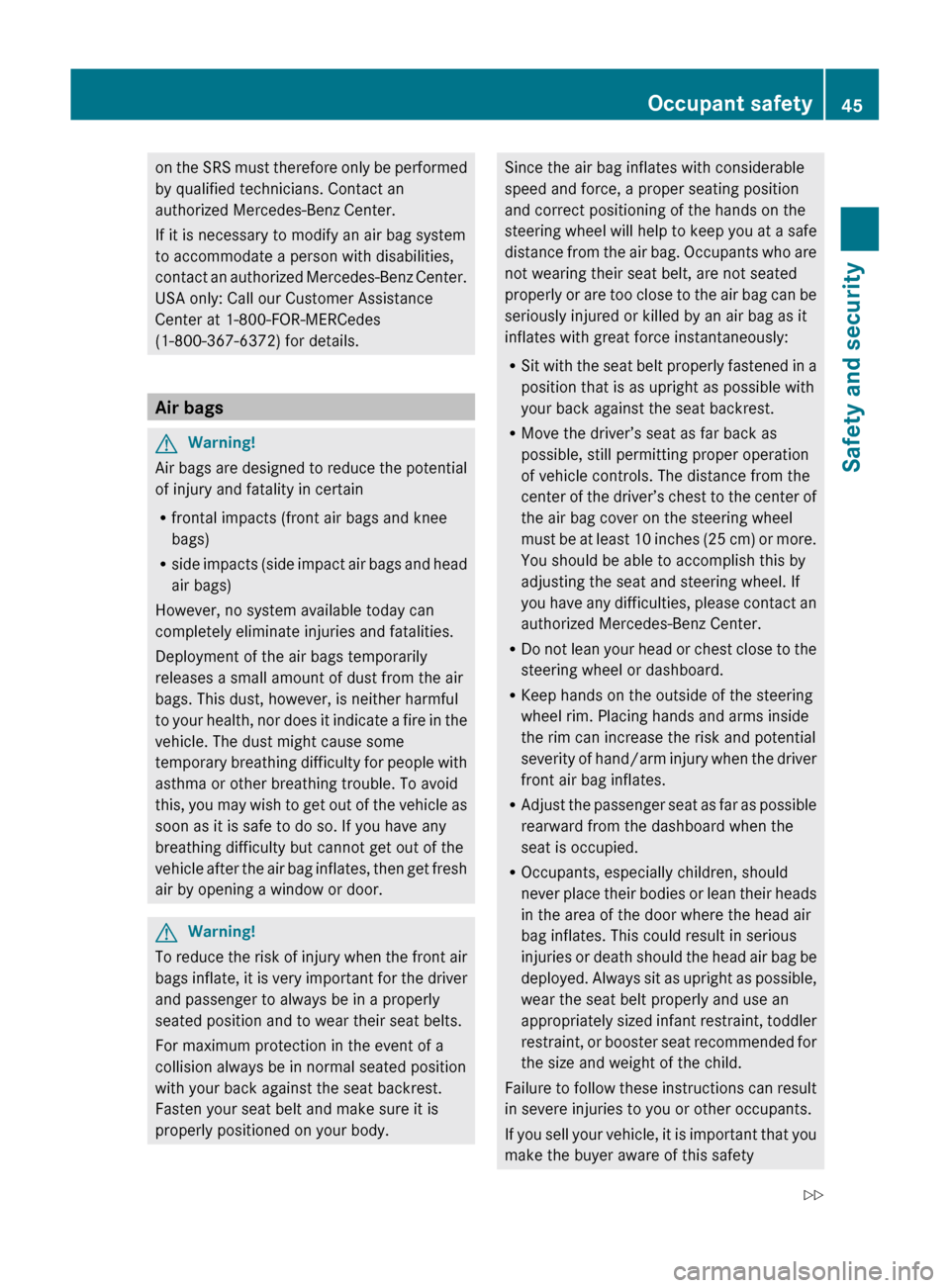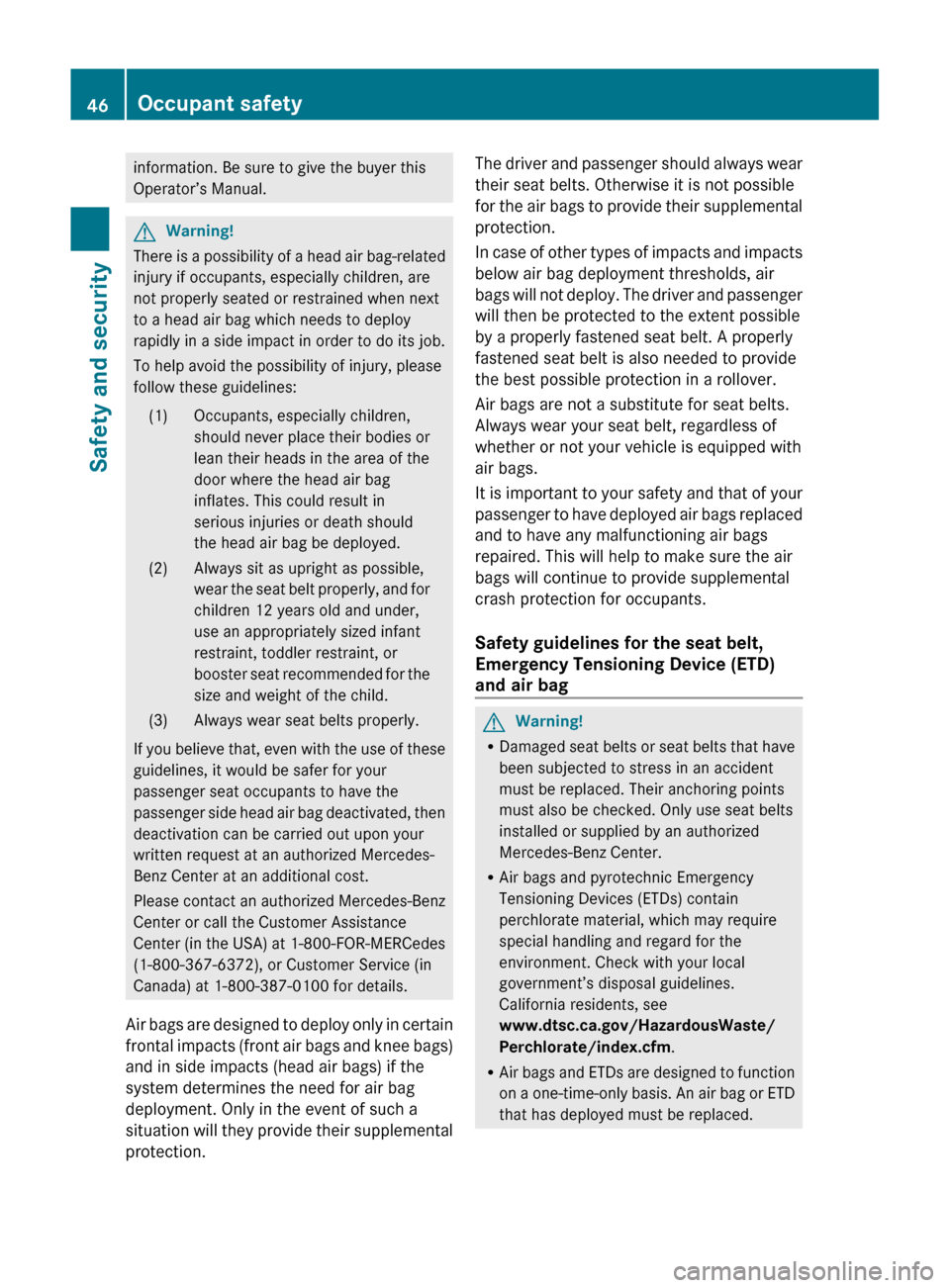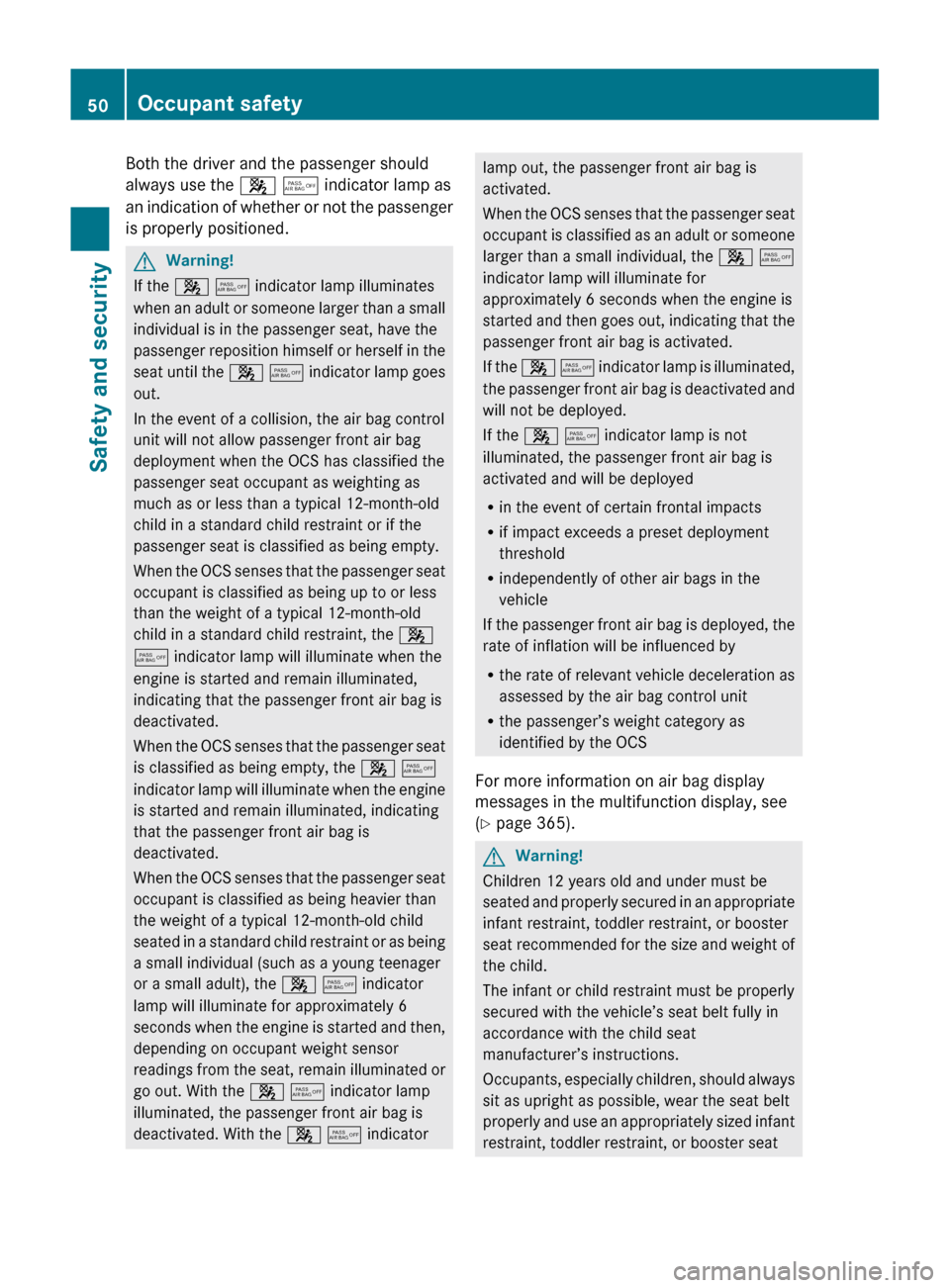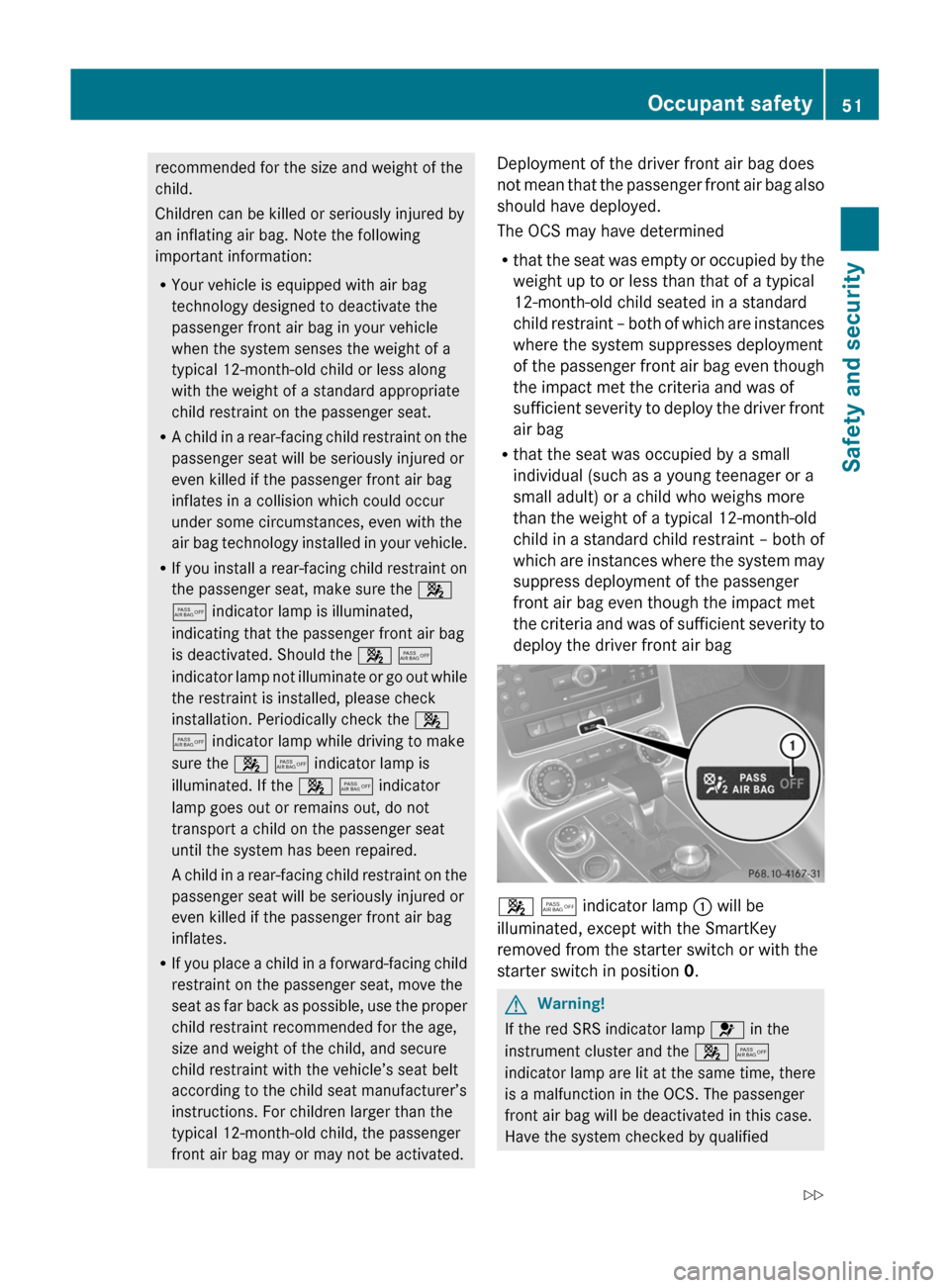2011 MERCEDES-BENZ SLS child restraint
[x] Cancel search: child restraintPage 9 of 436

stopping or pausing playback ........186
voice control with ..................224, 229
Center console
Lower part ....................................... 39
Upper part ....................................... 38
Central locking
Automatic ...................................... 239
Locking/unlocking from inside ......239
SmartKey ....................................... 236
Central locking/unlocking switch ... 239
Ceramic brake system ...................... 350
Certification label .............................. 420
Channel selection (satellite radio) ..... 83
voice commands for ......................223
Chapter selection (DVD)
main video ..................................... 203
Character entry ................................... 86
Children in the vehicle Air bags ........................................... 45
Indicator lamp, passenger front
air bag off ........................................ 49
Infant and child restraint systems .... 58
OCS (Occupant Classification
System) ........................................... 49
Safety notes ..................................... 57
Tether anchorage points ..................59
Top tether ........................................ 59
Child safety
see Children in the vehicle
Chrome-plated exhaust tip,
cleaning .............................................. 360
Cigarette lighter ................................ 307
City center, selecting as
destination ................................. 119, 214
City of destination, selecting ........... 115
Clear button ......................................... 79
Climate control system .................... 298
Air conditioning ............................. 300
Air conditioning refrigerant ............426
Air distribution ............................... 302
Air recirculation mode ...................303
Air vents ........................................ 301
Air volume ..................................... 302
Automatic mode ............................ 300
Deactivating system ......................299
Front defroster .............................. 302
Maximum cooling MAX COOL ........303Temperature .................................. 300
Using driver-side settings for
passenger side ............................... 303
Cockpit ................................................. 33
Cold tire inflation pressure .............. 345
Collapsible wheel chock ................... 363
Color video settings main video ..................................... 203
COMAND
control unit ...................................... 75
Reset ............................................... 99
System settings ............................... 92
COMAND, about
basic functions ................................ 89
operation of ..................................... 85
switching on/off .............................. 89
COMAND components ........................ 73
COMAND controller ............................. 77
COMAND Control System ................... 72
Combination switch .......................... 251
Commands for voice control ............ 225
for address book ...................219, 227
for CD, DVD, MP3 ..................224, 229
for navigation ........................ 212, 226
for phone operation .......................226
for radio and satellite radio .... 221, 228
general commands ........................225
Contacts
see Address book
Contrast setting
main video ..................................... 203
Control system .................................. 272
Multifunction display .....................273
Multifunction steering wheel .........272
Resetting to factory settings ..........282
Submenus in the Settings menu ....283
Control system menus ...................... 275
AMG ............................................... 287
Audio ............................................. 279
Navi ............................................... 277
Service ........................................... 281
Settings ......................................... 282
Telephone ...................................... 280
Trip ................................................ 275
Control system submenus
Convenience .................................. 286
Instrument cluster .........................283Index7BA 197 USA, CA Edition A 2011; 1; 27, en-UShereepeVersion: 3.0.3.52010-03-24T15:31:10+01:00 - Seite 7
Page 14 of 436

GVW (Gross Vehicle Weight) ............ 345
GVWR (Gross Vehicle Weight
Rating) ................................................ 345
H
Hands-free microphone, switching
on/off ................................................. 160
Hanging up (phone calls) .................. 160
Hard disk drive voice control with ..................225, 229
Hard plastic trim items, cleaning .... 359
Hazard warning flasher .................... 252
Head air bags ....................................... 49
Headlamp cleaning system .............. 252
Headlamps Automatic headlamp mode ............250
Bi-Xenon ........................................ 249
Cleaning lenses ............................. 357
Cleaning system ............................ 252
Daytime running lamp mode ..........251
Delayed shut-off ............................ 285
High-beam flasher .........................252
High-beam headlamps ...................252
Low-beam headlamps ....................250
Replacing bulbs ............................. 400
Switch ............................................ 250
Headliner, cleaning and care of ....... 359
Height adjustment Seats ............................................. 243
Help with voice control, general ...... 232
High-beam flasher ............................. 252
High-beam headlamps ...................... 252
Indicator lamp .................................. 35
High-performance brake system ..... 350
Highway information, displaying ..... 111
Highway junctions, selecting as
destination ......................................... 120
Hill-start assist system ..................... 293
Home address in destination
memory ...................................... 122, 143
deleting .......................................... 146
setting or changing ........................143
Hood ................................................... 322
Messages in the multifunction
display ........................................... 379
Horn ...................................................... 33
House numbers, entering for
destination ................................. 119, 215
Hydroplaning ..................................... 351
I
Identification labels .......................... 420
Identification number, vehicle
(VIN) ................................................... 421
Ignition ............................... 241, 242, 258
Immobilizer .......................................... 66
Incident (traffic notification) ............ 139
Incoming calls answering ...................................... 158
rejecting .................................. 84, 158
Infant and child restraint systems
see Children in the vehicle
Inflation pressure
see Tires, Inflation pressure
Initiating phone calls
see Calling
Input of navigation destination ........ 114
speed restriction on ..............102, 123
Input speller
settings for address book ..............157
Installing map data ........................... 100
Instrument cluster ...................... 34, 271
Lamps ............................................ 388
Multifunction display .....................273
Instrument panel
see Instrument cluster
Instruments and controls
see Cockpit
Interactive content on DVDs ............ 205
Interior lighting ................................. 253
Delayed shut-off ............................ 286
Emergency lighting ........................253
Reading lamps ............................... 253
Interior rear view mirror ................... 246
Auto-dimming rear view mirrors ....247
Interior storage spaces
see Storage compartments
Intermittent wiping ........................... 254
Rain sensor .................................... 254
Interrupting audio playback ............. 186
Interrupting video playback ............. 202
Intersection (selecting) .................... 215
12IndexBA 197 USA, CA Edition A 2011; 1; 27, en-UShereepeVersion: 3.0.3.52010-03-24T15:31:10+01:00 - Seite 12
Page 18 of 436

Buttons .................................. 272, 273
Cleaning ......................................... 359
Easy-entry/exit feature .........245, 286
Gearshift control ............................ 267
Memory function ........................... 249
Overview .......................................... 36
voice control button ....................... 208
Multisession CDs ............................... 178
Music register ................................... 189
Deleting ......................................... 191
Folder functions ............................. 191
Memory space info ........................191
Playback options ........................... 192
recording ....................................... 190
switching on .................................. 189
voice control with ..................225, 229
Muting audio
main system .................................... 89
navigation announcements ......89, 137
My address (destination) .......... 122, 143
deleting from destination memory . 146
setting or changing ........................143
N
Names for MP3 files and folders ................ 178
for saved destinations ...................146
searching for POIs by .....................127
Navigation (See also Route
guidance) ............................................. 99
audio fadeout ..................89, 112, 137
basic settings ................................ 107
destination input ............................ 114
destination memory .......................143
displaying/hiding menu system .....106
general information .......................102
last destinations ............................ 147
map display ................................... 108
menu overview .............................. 103
operational readiness ....................102
POI input ........................................ 126
scrolling the map ........................... 106
setting map scale .......................... 106
steering wheel operation .................81
switching to navigation mode ........105
to address book destinations ........165
traffic messages ............................ 139
updating map software ..................100
voice control with ..................212, 226
Navigation
announcements ................ 133, 137, 206
during active phone calls ...............137
switching on/off ......................89, 137
volume of ......................................... 89
Navigation system
Control system .............................. 277
Navi menu ........................... 81, 103, 277
Near destination, entering POI ........ 126
Net, parcel ......................................... 304
Network coverage for phone calls .. 148
Normal occupant weight .................. 346
Normal track sequence .................... 189
Number, vehicle identification
(VIN) ................................................... 421
Number keypad entering characters with ..................87
Numbers, entering with voice
command ........................................... 209
O
Occupant Classification System see OCS (Occupant Classification
System)
Occupant distribution ....................... 346
Occupant safety Air bags ........................................... 45
Children and air bags .......................45
Children in the vehicle .....................57
Fastening the seat belts ................... 54
Infant and child restraint systems .... 58
Introduction ..................................... 44
OCS (Occupant Classification
System) ........................................... 49
Passenger front air bag off
indicator lamp .......................... 49, 396
Seat belts .................................. 46, 52
OCS (Occupant Classification
System) ................................................ 49
Self-test ........................................... 52
Odometer ........................................... 275
Off-map routes .................................. 135
Off-road routes .................................. 135
Oil, oil level see Engine oil
16IndexBA 197 USA, CA Edition A 2011; 1; 27, en-UShereepeVersion: 3.0.3.52010-03-24T15:31:10+01:00 - Seite 16
Page 46 of 436

Vehicle equipment
i This Operator’s Manual describes all
features, standard or optional, potentially
available for your vehicle at the time of
purchase. Please be aware that your
vehicle might not be equipped with all
features described in this manual.
Occupant safety
Introduction
In this section you will learn the most
important facts about the restraint system
components of the vehicle.
The restraint systems are:
R Seat belts
R Child restraints
Additional protection potential is provided by:
R Supplemental Restraint System (SRS) with
- Air bags
- Air bag control unit (with crash sensors)
- Emergency Tensioning Device (ETD) for
seat belts
- Seat belt force limiter
R Air bag system components with
- Passenger front air bag off indicator lamp
- Passenger seat with Occupant
C lassification System (OCS)
Although the systems are independent, their
protective functions work in conjunction with
each other.
GWarning!
Modifications to or work improperly
conducted on restraint system components
or their wiring, as well as tampering with
interconnected electronic systems, can lead
to the restraint systems no longer functioning
as intended.
Air bags or Emergency Tensioning Devices
(ETDs), for example, could deploy
inadvertently or fail to deploy in accidents
although the deceleration threshold for air
bag deployment is exceeded. Therefore,
never modify the restraint systems. Do not
tamper with electronic components or their
software.
i See “Children in the vehicle”
( Y page 57) for information on
R infants and children traveling with you in
the vehicle
R restraint systems for infants and children
SRS indicator lamp
The SRS system conducts a self-test when
the ignition is switched on and in regular
intervals while the engine is running. This
facilitates detection of system malfunctions.
The SRS indicator lamp 6 in the
instrument cluster comes on when the
ignition is switched on. It goes out no later
than a few seconds after the engine has been
started.
GWarning!
The SRS self-check has detected a
malfunction when the SRS indicator lamp
6
R does not come on at all
R fails to go out after approximately
4 seconds after the engine was started
R comes on after the engine was started or
while driving
For your safety, we strongly recommend that
you contact an authorized Mercedes-Benz
Center immediately to have the system
checked. Otherwise the SRS may not be
activated when needed in an accident, which
could result in serious or fatal injury. The SRS
might also deploy unexpectedly and
unnecessarily which could also result in injury
as well.
In addition, improper work on the SRS creates
a risk of rendering the SRS inoperative or
causing unintended air bag deployment. Work
44Occupant safetySafety and security
BA 197 USA, CA Edition A 2011; 1; 27, en-UShereepeVersion: 3.0.3.52010-03-24T15:31:10+01:00 - Seite 44
Page 47 of 436

on the SRS must therefore only be performed
by qualified technicians. Contact an
authorized Mercedes-Benz Center.
If it is necessary to modify an air bag system
to accommodate a person with disabilities,
contact an authorized Mercedes-Benz Center.
USA only: Call our Customer Assistance
Center at 1-800-FOR-MERCedes
(1-800-367-6372) for details.
Air bags
GWarning!
Air bags are designed to reduce the potential
of injury and fatality in certain
R frontal impacts (front air bags and knee
bags)
R side impacts (side impact air bags and head
air bags)
However, no system available today can
completely eliminate injuries and fatalities.
Deployment of the air bags temporarily
releases a small amount of dust from the air
bags. This dust, however, is neither harmful
to your health, nor does it indicate a fire in the
vehicle. The dust might cause some
temporary breathing difficulty for people with
asthma or other breathing trouble. To avoid
this, you may wish to get out of the vehicle as
soon as it is safe to do so. If you have any
breathing difficulty but cannot get out of the
vehicle after the air bag inflates, then get fresh
air by opening a window or door.
GWarning!
To reduce the risk of injury when the front air
bags inflate, it is very important for the driver
and passenger to always be in a properly
seated position and to wear their seat belts.
For maximum protection in the event of a
collision always be in normal seated position
with your back against the seat backrest.
Fasten your seat belt and make sure it is
properly positioned on your body.
Since the air bag inflates with considerable
speed and force, a proper seating position
and correct positioning of the hands on the
steering wheel will help to keep you at a safe
distance from the air bag. Occupants who are
not wearing their seat belt, are not seated
properly or are too close to the air bag can be
seriously injured or killed by an air bag as it
inflates with great force instantaneously:
R Sit with the seat belt properly fastened in a
position that is as upright as possible with
your back against the seat backrest.
R Move the driver’s seat as far back as
possible, still permitting proper operation
of vehicle controls. The distance from the
center of the driver’s chest to the center of
the air bag cover on the steering wheel
must be at least 10 inches (25 cm) or more.
You should be able to accomplish this by
adjusting the seat and steering wheel. If
you have any difficulties, please contact an
authorized Mercedes-Benz Center.
R Do not lean your head or chest close to the
steering wheel or dashboard.
R Keep hands on the outside of the steering
wheel rim. Placing hands and arms inside
the rim can increase the risk and potential
severity of hand/arm injury when the driver
front air bag inflates.
R Adjust the passenger seat as far as possible
rearward from the dashboard when the
seat is occupied.
R Occupants, especially children, should
never place their bodies or lean their heads
in the area of the door where the head air
bag inflates. This could result in serious
injuries or death should the head air bag be
deployed. Always sit as upright as possible,
wear the seat belt properly and use an
appropriately sized infant restraint, toddler
restraint, or booster seat recommended for
the size and weight of the child.
Failure to follow these instructions can result
in severe injuries to you or other occupants.
If you sell your vehicle, it is important that you
make the buyer aware of this safetyOccupant safety45Safety and securityBA 197 USA, CA Edition A 2011; 1; 27, en-UShereepeVersion: 3.0.3.52010-03-24T15:31:10+01:00 - Seite 45Z
Page 48 of 436

information. Be sure to give the buyer this
Operator’s Manual.GWarning!
There is a possibility of a head air bag-related
injury if occupants, especially children, are
not properly seated or restrained when next
to a head air bag which needs to deploy
rapidly in a side impact in order to do its job.
To help avoid the possibility of injury, please
follow these guidelines:
(1)Occupants, especially children,
should never place their bodies or
lean their heads in the area of the
door where the head air bag
inflates. This could result in
serious injuries or death should
the head air bag be deployed.(2)Always sit as upright as possible,
wear the seat belt properly, and for
children 12 years old and under,
use an appropriately sized infant
restraint, toddler restraint, or
booster seat recommended for the
size and weight of the child.(3)Always wear seat belts properly.
If you believe that, even with the use of these
guidelines, it would be safer for your
passenger seat occupants to have the
passenger side head air bag deactivated, then
deactivation can be carried out upon your
written request at an authorized Mercedes-
Benz Center at an additional cost.
Please contact an authorized Mercedes-Benz
Center or call the Customer Assistance
Center (in the USA) at 1-800-FOR-MERCedes
(1-800-367-6372), or Customer Service (in
Canada) at 1-800-387-0100 for details.
Air bags are designed to deploy only in certain
frontal impacts (front air bags and knee bags)
and in side impacts (head air bags) if the
system determines the need for air bag
deployment. Only in the event of such a
situation will they provide their supplemental
protection.
The driver and passenger should always wear
their seat belts. Otherwise it is not possible
for the air bags to provide their supplemental
protection.
In case of other types of impacts and impacts
below air bag deployment thresholds, air
bags will not deploy. The driver and passenger
will then be protected to the extent possible
by a properly fastened seat belt. A properly
fastened seat belt is also needed to provide
the best possible protection in a rollover.
Air bags are not a substitute for seat belts.
Always wear your seat belt, regardless of
whether or not your vehicle is equipped with
air bags.
It is important to your safety and that of your
passenger to have deployed air bags replaced
and to have any malfunctioning air bags
repaired. This will help to make sure the air
bags will continue to provide supplemental
crash protection for occupants.
Safety guidelines for the seat belt,
Emergency Tensioning Device (ETD)
and air bag GWarning!
R Damaged seat belts or seat belts that have
been subjected to stress in an accident
must be replaced. Their anchoring points
must also be checked. Only use seat belts
installed or supplied by an authorized
Mercedes-Benz Center.
R Air bags and pyrotechnic Emergency
Tensioning Devices (ETDs) contain
perchlorate material, which may require
special handling and regard for the
environment. Check with your local
government’s disposal guidelines.
California residents, see
www.dtsc.ca.gov/HazardousWaste/
Perchlorate/index.cfm .
R Air bags and ETDs are designed to function
on a one-time-only basis. An air bag or ETD
that has deployed must be replaced.
46Occupant safetySafety and security
BA 197 USA, CA Edition A 2011; 1; 27, en-UShereepeVersion: 3.0.3.52010-03-24T15:31:10+01:00 - Seite 46
Page 52 of 436

Both the driver and the passenger should
always use the 4 5 indicator lamp as
an indication of whether or not the passenger
is properly positioned.GWarning!
If the 4 5 indicator lamp illuminates
when an adult or someone larger than a small
individual is in the passenger seat, have the
passenger reposition himself or herself in the
seat until the 4 5 indicator lamp goes
out.
In the event of a collision, the air bag control
unit will not allow passenger front air bag
deployment when the OCS has classified the
passenger seat occupant as weighting as
much as or less than a typical 12-month-old
child in a standard child restraint or if the
passenger seat is classified as being empty.
When the OCS senses that the passenger seat
occupant is classified as being up to or less
than the weight of a typical 12-month-old
child in a standard child restraint, the 4
5 indicator lamp will illuminate when the
engine is started and remain illuminated,
indicating that the passenger front air bag is
deactivated.
When the OCS senses that the passenger seat
is classified as being empty, the 4 5
indicator lamp will illuminate when the engine
is started and remain illuminated, indicating
that the passenger front air bag is
deactivated.
When the OCS senses that the passenger seat
occupant is classified as being heavier than
the weight of a typical 12-month-old child
seated in a standard child restraint or as being
a small individual (such as a young teenager
or a small adult), the 4 5 indicator
lamp will illuminate for approximately 6
seconds when the engine is started and then,
depending on occupant weight sensor
readings from the seat, remain illuminated or
go out. With the 4 5 indicator lamp
illuminated, the passenger front air bag is
deactivated. With the 4 5 indicator
lamp out, the passenger front air bag is
activated.
When the OCS senses that the passenger seat
occupant is classified as an adult or someone
larger than a small individual, the 4 5
indicator lamp will illuminate for
approximately 6 seconds when the engine is
started and then goes out, indicating that the
passenger front air bag is activated.
If the 4 5 indicator lamp is illuminated,
the passenger front air bag is deactivated and
will not be deployed.
If the 4 5 indicator lamp is not
illuminated, the passenger front air bag is
activated and will be deployed
R in the event of certain frontal impacts
R if impact exceeds a preset deployment
threshold
R independently of other air bags in the
vehicle
If the passenger front air bag is deployed, the
rate of inflation will be influenced by
R the rate of relevant vehicle deceleration as
assessed by the air bag control unit
R the passenger’s weight category as
identified by the OCS
For more information on air bag display
messages in the multifunction display, see
( Y page 365).GWarning!
Children 12 years old and under must be
seated and properly secured in an appropriate
infant restraint, toddler restraint, or booster
seat recommended for the size and weight of
the child.
The infant or child restraint must be properly
secured with the vehicle’s seat belt fully in
accordance with the child seat
manufacturer’s instructions.
Occupants, especially children, should always
sit as upright as possible, wear the seat belt
properly and use an appropriately sized infant
restraint, toddler restraint, or booster seat
50Occupant safetySafety and security
BA 197 USA, CA Edition A 2011; 1; 27, en-UShereepeVersion: 3.0.3.52010-03-24T15:31:10+01:00 - Seite 50
Page 53 of 436

recommended for the size and weight of the
child.
Children can be killed or seriously injured by
an inflating air bag. Note the following
important information:
RYour vehicle is equipped with air bag
technology designed to deactivate the
passenger front air bag in your vehicle
when the system senses the weight of a
typical 12-month-old child or less along
with the weight of a standard appropriate
child restraint on the passenger seat.
RA child in a rear-facing child restraint on the
passenger seat will be seriously injured or
even killed if the passenger front air bag
inflates in a collision which could occur
under some circumstances, even with the
air bag technology installed in your vehicle.
RIf you install a rear-facing child restraint on
the passenger seat, make sure the 4
5 indicator lamp is illuminated,
indicating that the passenger front air bag
is deactivated. Should the 4 5
indicator lamp not illuminate or go out while
the restraint is installed, please check
installation. Periodically check the 4
5 indicator lamp while driving to make
sure the 4 5 indicator lamp is
illuminated. If the 4 5 indicator
lamp goes out or remains out, do not
transport a child on the passenger seat
until the system has been repaired.
A child in a rear-facing child restraint on the
passenger seat will be seriously injured or
even killed if the passenger front air bag
inflates.
RIf you place a child in a forward-facing child
restraint on the passenger seat, move the
seat as far back as possible, use the proper
child restraint recommended for the age,
size and weight of the child, and secure
child restraint with the vehicle’s seat belt
according to the child seat manufacturer’s
instructions. For children larger than the
typical 12-month-old child, the passenger
front air bag may or may not be activated.
Deployment of the driver front air bag does
not mean that the passenger front air bag also
should have deployed.
The OCS may have determined
Rthat the seat was empty or occupied by the
weight up to or less than that of a typical
12-month-old child seated in a standard
child restraint – both of which are instances
where the system suppresses deployment
of the passenger front air bag even though
the impact met the criteria and was of
sufficient severity to deploy the driver front
air bag
Rthat the seat was occupied by a small
individual (such as a young teenager or a
small adult) or a child who weighs more
than the weight of a typical 12-month-old
child in a standard child restraint – both of
which are instances where the system may
suppress deployment of the passenger
front air bag even though the impact met
the criteria and was of sufficient severity to
deploy the driver front air bag
4 5 indicator lamp : will be
illuminated, except with the SmartKey
removed from the starter switch or with the
starter switch in position 0.
GWarning!
If the red SRS indicator lamp 6 in the
instrument cluster and the 4 5
indicator lamp are lit at the same time, there
is a malfunction in the OCS. The passenger
front air bag will be deactivated in this case.
Have the system checked by qualified
Occupant safety51Safety and securityBA 197 USA, CA Edition A 2011; 1; 27, en-UShereepeVersion: 3.0.3.52010-03-24T15:31:10+01:00 - Seite 51Z